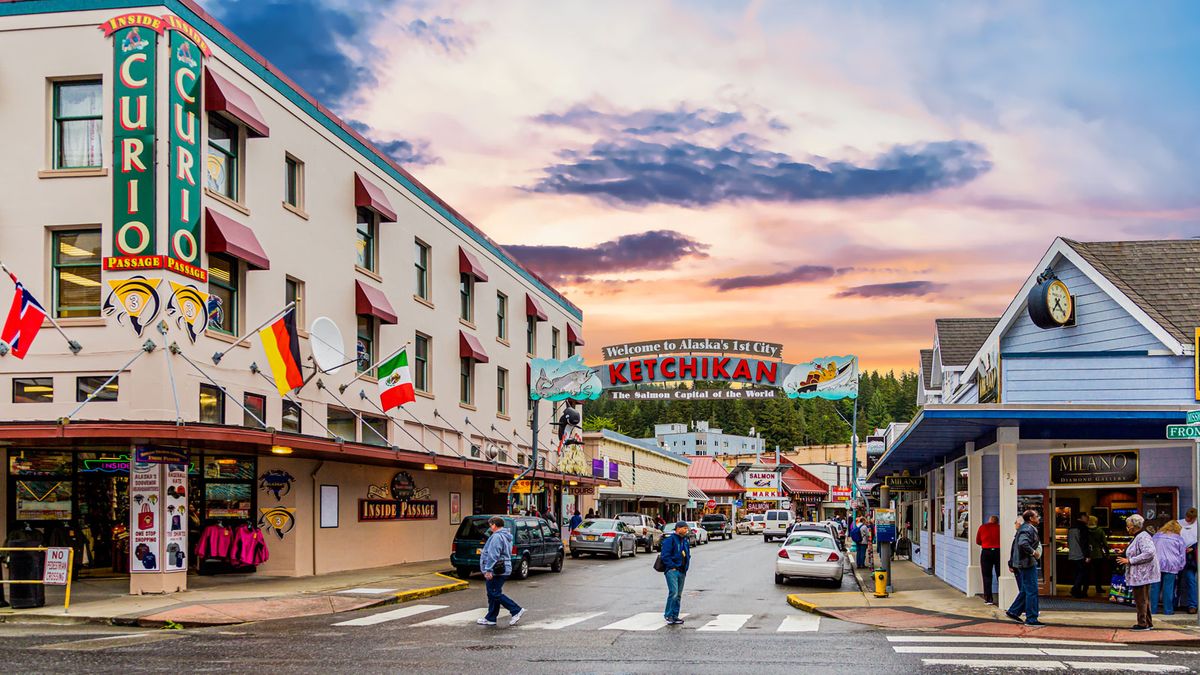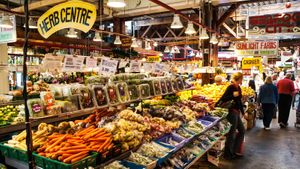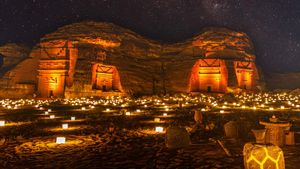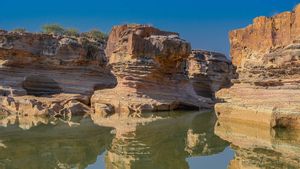Resting my elbows on the balcony railing, I am taking in the unobstructed views of the Tongass National Forest from Norwegian Cruise Line’s Norwegian Jewel which is sailing from bustling Vancouver to scenic Alaska. The cruise is drifting towards Ketchikan, an Alaskan city facing the Inside Passage, a popular cruise ship route along the state's southeastern coast. As the ship docks in the vibrant downtown, I am greeted by a sign that reads 'Welcome to Alaska's 1st City - Ketchikan - The Salmon Capital of the World'.

My friend and I are quick to hop off the cruise to make the most of our time in this quiet town, which is full of fishermen, forested hills and facades painted in all possible colours of the rainbow. While Ketchikan is cold, wet and grey on most days, these vivid shops and houses add the perfect dash of liveliness, making the cityscape picturesque.
The state’s fourth-largest city, Ketchikan sees rain so often that locals call it "liquid sunshine" and rarely step out with their umbrellas. However, we are dressed warmly and in layers, prepared to take off an extra layer when the sun is out, throw on a jacket if it's a bit chilly or simply wrap ourselves in a rain poncho, in case of a downpour.
Strolling through Creek Street
To shake off the rainy-day gloominess, we buy a tub of buttery popcorn and walk towards Creek Street, a walkway of wooden planks perched over Ketchikan Creek. Standing atop the antique boardwalk, we see hundreds of salmon swimming upstream; seals and otters gambolling around in the water and eagles lounging in their nests.
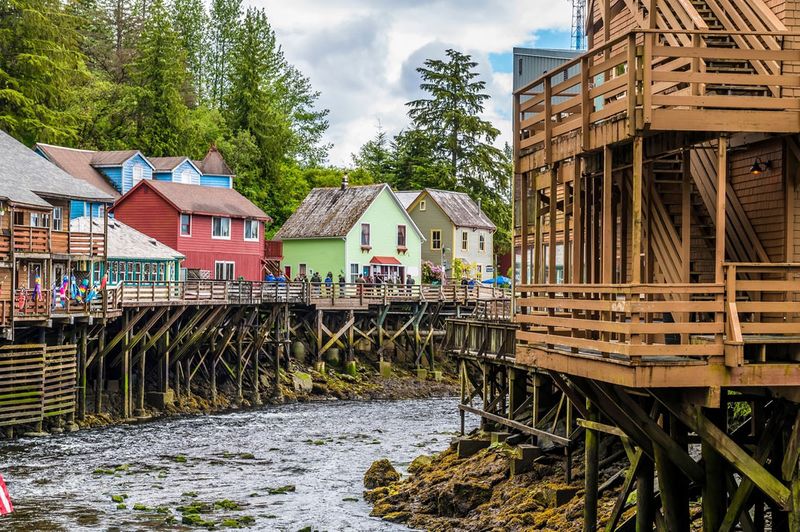
Once a notorious red-light district “where fish and fishermen came to spawn”, Creek Street’s many brothels have been transformed into little souvenir shops selling curios and knick-knacks. Among traces of its questionable heyday is the historical Dolly’s House, a garishly decorated place where a famous Dolly Arthur conducted business from 1919 to the 1940s.
We also pop into Star House, which was once a dance hall and the only registered brothel in Alaska. What attracts our attention is the Married Man’s Trail, a route used by men to discreetly visit the bordellos instead of being ‘caught’ walking in the front doors! The trail ends at Salmon Ladder which is a delightful spot to watch struggling salmon trying to jump up the rushing waterfall.
Admiring Tongass National Forest up-close
To ditch the tourist trap and enjoy the tranquil setting of the Tongass in seclusion, we choose a kayaking adventure that begins with a drive over to the serene and beautiful Clover Pass. After learning the basics of paddling and wearing our life jackets and spray skirts, we are ready to pick up a double-bladed paddle each and take off in a kayak.
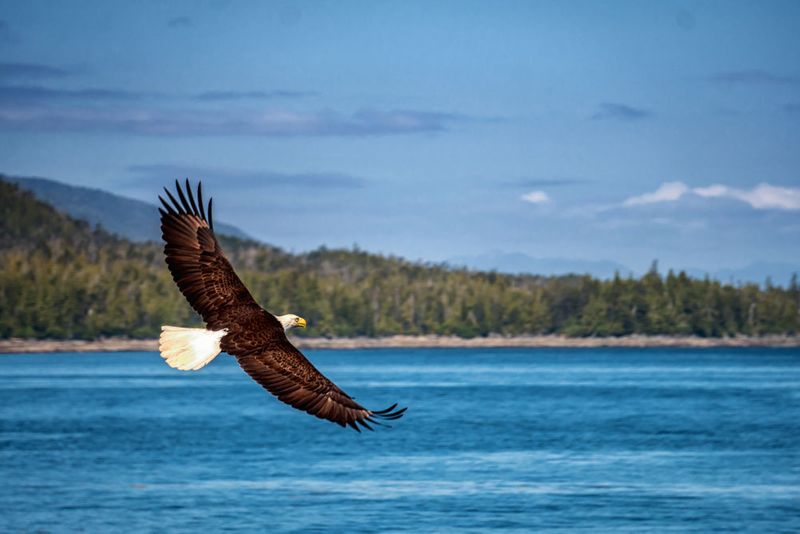
Surrounded by the protected, crystal-clear waters of Clover Pass, we are more aware of the sublime beauty and vastness of the landscape. Tree-covered hills are dotted with little houses, rainforest growth hugs the shoreline of rugged islands and clouds transform the skies into a pretty postcard.
Proceeding towards Eagle Island, my friend controls the direction of the kayak while I focus on getting my strokes right. Now and then, we are tempted to keep our paddles away, pull out our phones and cameras from the dry pack fastened to the kayak and capture the wonders of Alaskan nature.
This gorgeous arm of the Pacific Ocean is rich in a variety of marine life like seals, Pacific porpoises, and humpback and orca whales apart from Sitka deer. We make sure to keep our eyes peeled so as not to miss spotting any of these creatures in their natural habitat. Brightly-coloured starfish in various shades of red, orange, blue and green make a frequent appearance while bald eagles soar overhead.
Feasting on local salmon
After two hours of rowing, we've worked up an appetite for a picnic of locally-sourced salmon. So, we call for two wild Alaskan smoked sockeye salmon crepes to relish with local craft beer.
While the succulent and tender fish melts in the mouth, releasing its subtle, smoky flavours with each bite, add-ons like chevre (goat) cheese, green onions, baby spinach and dill aioli help balance out the taste. Sipping on the chilled brew, we recall the eventful day in silence.
With its storied history and culture and jaw-droppingly beautiful wilderness, Ketchikan has certainly rejuvenated and inspired us. We imagine what it would be like to live in one of the most remote, unspoiled places in the world. Filled with a rush of mixed emotions, we bid goodbye to the captivating destination only with a promise to be back.
Did you know?
Ketchikan is called Alaska's ‘first city’ because of its geographic location at the tip of the Inside Passage, on the western coast of Revillagigedo Island.
4 other must-dos in Ketchikan
1. Let totem poles narrate a story

Ketchikan’s totem poles are among the city’s most striking sights. They were carved to honour important people and record noteworthy events. Visit the Totem Heritage Center to witness the largest collection of standing totem poles created by Tlingit and Haida Indians. Each of the giant pieces of art is painted in rich, contrasting colours and displays haunting forms of animals, mythological beings and people. For newer totem poles hand-carved by Alaskan native artists, visit Saxman Totem Park, Totem Bight State Park and Potlatch Park.
2. Delver deeper into Alaska's logging history

Treat yourself to an action-packed, thrilling display of woodsmen skills to learn all about Southeast Alaska’s rich logging history. Watching burly lumberjacks freefall from tall trees, scamper across logs floating in the water and show off their strength as they chop and saw through thick logs is likely to have you on the edge of your seat.
3. Don't miss the ‘the Mistys’

For picture-postcard views, take a trip to Misty Fjords National Monument. A natural mosaic of icy blue lakes, snow-capped peaks, glacial valleys, dramatic waterfalls and rock walls jutting 3,000 feet straight out of the ocean, Misty Fjords is Alaska's largest wilderness area and a photographer's dream. It is home to abundant wildlife which includes mountain goats, brown bears, black bears, moose, marten, wolves, wolverine, river otters, sea lions, harbour seals, killer whales and Dall porpoises as well as hummingbirds, trumpeter swans, herons and bald eagles. You can get here only by seaplane or boat.
4. Go hiking for the views

Ketchikan has several hiking trails, including one to the top of Deer Mountain. This 4-km hike goes up 2,500 feet to the summit, offering marvellous views of Ketchikan. Conveniently located close to the Cruise Ship Terminal, Rainbird Trail is a delightful 2-km mile trail that winds through the old-growth rainforest with towering trees, shrubs and ferns before treating you to striking views and a splendid sunset that illuminates the town and water in shades of orange, red and pink.
What to eat and edible souvenirs to buy

Better known as the ‘Salmon Capital of the World’, Ketchikan is where you can feast on the freshest salmon along with halibut, crab, shrimp, oysters and clams, all of which come straight from the icy cold waters of the Pacific Ocean.
When dining at local restaurants and bars, consider ordering a bowl of creamy seafood chowder or a salmon burger, crepe or roll.
At Salmon Market, sample local Alaskan foods and pack some as souvenirs to take home. Think canned smoked salmon, salmon fillets, salmon jerky, caviar, spreads, reindeer sausages and wild berry Alaskan jams and jellies.
Ketchikan’s weather
Ketchikan is one of the rainiest places in North America and is typically cool and damp. Spring and summer (April to August) are the best times to visit this popular cruise port in Alaska’s Inside Passage as the weather is mildly comfortable with less rainfall. The warmest month is July and the coolest month is January. The key to enjoying Ketchikan is to dress in layers!


